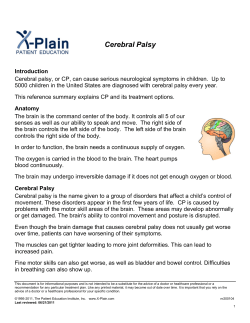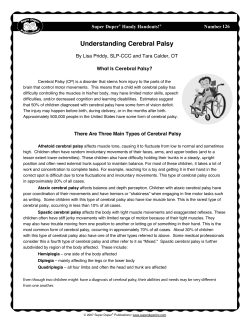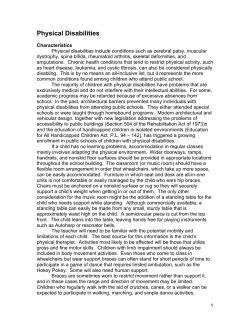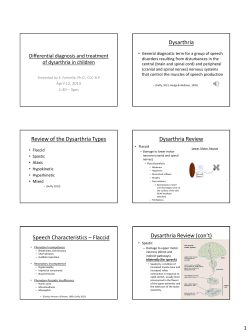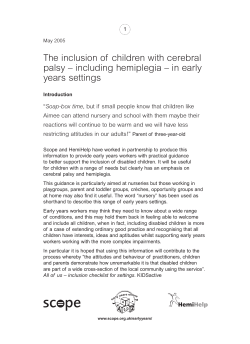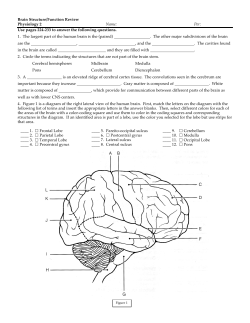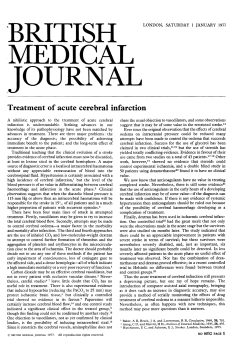
Susan R Harris and Beverley D Lundgren 1991; 71:890-896. PHYS THER.
Joint Mobilization for Children with Central Nervous System Disorders: Indications and Precautions Susan R Harris and Beverley D Lundgren PHYS THER. 1991; 71:890-896. The online version of this article, along with updated information and services, can be found online at: http://ptjournal.apta.org/content/71/12/890 Collections This article, along with others on similar topics, appears in the following collection(s): Cerebral Palsy Cerebral Palsy (Pediatrics) Manual Therapy Musculoskeletal System/Orthopedic: Other Pediatrics: Other e-Letters To submit an e-Letter on this article, click here or click on "Submit a response" in the right-hand menu under "Responses" in the online version of this article. E-mail alerts Sign up here to receive free e-mail alerts Downloaded from http://ptjournal.apta.org/ by guest on August 22, 2014 - Joint Mobilization for Children with Central Nervous System Disorders: Indications and Precautions Because clinicians are introducingjoint mobilization into treatment programs for children with cerebral palsy, we felt that a review of the procedure and its scientific basis would be timely. i%e goals of the introductory section of this article are to definejoint mobilization as it has been used for adults with musculoskeletal disabilities, to discuss various rationalesfor its effects, to describe cmaindications andprecautions for its use, and to discuss its e m as reported in the research literature. i%e latter part of the article deals with the use of joint mobilization f m children with central n m u s system (CNS) disorders. In an effm to umiktandprecautionsf m the use of joint mobilization in children, musculoskeletal development will be described bothf m ty~icallydeveloping children and f m chiIdren with spastic cerebral palsy. Indications f m using joint mobilization techniques in children with spasticity will be outlined. Speczfi neurodevelopmental disabilities for whichjoint mobilization wouu be sn-ongly contraindicated will be listed. Finally,future research directions in evaluating reliability of assessment of joint dysfunction and eficaq of joint mobilization in children will be discussed [Harris SR, Lundgren BD. Joint mobilizationf m children with central nervous system disorders: indications and precautions. Phys i%er. 1991;71:&90+96.] Susan R Harris Beverley D Lundgren Key Words: Cerebralpalj?Joint mobilization, Manual therapu. Since the early 1970s, there has been a steady increase in the use of joint mobilization techniques by physical therapists.' The primary indication for use has been mechanical joint dysfunction in which there is restriction of joint play (accessory motion) leading to pain or limitation of active physiological m ~ v e m e n tJoint . ~ mobilization has most often been used in the evaluation and treatment of patients who have musculoskeletal disabilities of the spine and extremities. More recently, Cochrane3 has suggested mobilization as an appropriate form of treatment for some of the joint restrictions that occur in chil- dren with cerebral palsy. The goals of the introductory section of this article are to define joint mobilization as used traditionally for adults with musculoskeletal disabilities, to discuss various rationales for its effects, to describe contraindications and precautions, and to discuss the efficacy of this treatment approach as reported in the research literature. The latter part of the article will deal with the applicability of joint mobilization for children with central nervous system (CNS) disorders. Definitions Used in its broadest sense,joint mobilization is a general term referring to any active or passive attempt to move a joint. As used in this article, the term is defined more specifically as anypassiue movement technique utilizing repetitive or oscillatory jointplay movements. Mobilization techniques are often graded as illustrated in Figure 1: Grade 1: a small-amplitude movement performed at the beginning of the range. Grade 2: a large-amplitude movement performed early in the range. Grade 3: a large-amplitude movement performed to the end of the range. SR Harris, PhD, PT, FAPTA, is Associate Professor, School of Rehabilitation Medicine, University of British Columbia, T325-2211, Wesbrook Mall, Vancouver, British Columbia, Canada V6T 285. Address all correspondence to Dr Harris. Grade 4: a small-amplitude movement performed at the end of the range.4 BD Lundgren, BFT, FT ' , is Instructor, School of Rehabilitation Medicine, University of British Columbia, and is in private practice in Vancouver, British Columbia, Canada. 22 / 890 Physical TherapyNolume 71, Number 12mecember 1991 Downloaded from http://ptjournal.apta.org/ by guest on August 22, 2014 Flgure 1. Grades of joint-play mouemat. (Adapted with pennission.2) When these grades are used, techniques are performed slowly and rhythmically, making it possible for the patient to use voluntary muscle contraction to prevent the therapist from administering the t e c h n i q ~ e z ~ e Grade 5 (Fig. 1) refers to manipulation, which is defined as a smallamplitude, high-velocity thrust applied to a joint at the limit of the available range of motion (ROM) and done so quickly that the patient cannot prevent the movement from taking place. Manipulation represents a progression beyond mobilization by providing a quick stretch to the joint, often accompanied by a cracking sound.418 There has been no suggestion in the physical therapy literature that manipulation would be an appropriate form of treatment for children with CNS disorders; indeed, common practice recognizes manipulation to be contraindicated in cases of "physical involvement of the CNS."9@446) The reader should be aware, however, of these distinctions when considering the topic of joint mobilization. The term manual therapy will be used to refer to both mobilization and manipulation procedures. Mechanical Jolnt Dysfunction Qsfinction is a nonspecific term used to describe a deviation from normal. In the case of joint dysfunction, there is either deviation from the normal scribed as being consistent in strength and position in the range of movement, whereas that produced by muscle spasm varies in response to the speed and method of the examination movement.' Skill and experience are required to appreciate these signs and symptoms when assessing the small movements associated with the peripheral and vertebral joints. The ability to reliably "feel" joint-play movements has been questioned by some authors12 and supported by others.l'J4 A recent study by Jull and colleagues13 confirmed the ability of a therapist to accurately diagnose cervical zygaphoseal joint syndromes using manual procedures, but additional studies are required in this area. expected movement or pain accompanying the movement.lo There are many different causes of mechanical Rationale tor the Effects of joint dysfunction. For example, periphMobllbatlon eral joint dysfunction can be due to capsular fibrosis, ligamentous adheThe mechanisms by which joint mobisions, joint effusion, subluxation, and lization o r manipulation "work are intra-anicular derangement.2 Spinal not known, although many hypothedysfunction has been related to disk ses have been proposed as our lesions with or without nerve root inknowledge of articular and soft tissue volvement, zygapophyseal joint adheneurology, biomechanics, and patholsions and derangements, segmental ogy has expanded. Although treatment hypermobility, and subluxations.4~~~~ rationales have been developed for the areas receiving the most research Not all types of joint dysfunction are attention (ie, spinal mobilization and appropriate for treatment by manual manipulation),l5 the proposed rationtherapy. Careful evaluation of the type ales for these effects can be applied to of dysfunction involves detailed asperipheral joints as well. Some of the The spesessment proced~res.5~Sll possible mechanisms for these effects cific signs and symptoms of the paare described in the following tient enable the physical therapist to paragraphs. develop a diagnosis and determine suitability for treatment. Careful analyNeurophysioiogi~~i Mechanisms sis of clinical features guides progresfor the Reduction of Pain sion of treatment. and Muscle Spasm Manual therapy has been stated to be Articular neurology has provided most effective when directed at "memuch of the background to underchanical joint dysfunction in which standing the effect of passive movethere is restriction of accessory moment in modulating pain. The type I, tion due to capsular o r ligamentous 11, and I11 mechanoreceptors located tightness or a~lherence."~@91) Assessin joint capsules and ligaments are ment, therefore, includes testing of stimulated by active and passive joint the accessory movements particular to movement.16 Type IV nociceptors are that joint to determine the presence completely inactive in normal situaof pain or resistance, o r both, to tions, but are stimulated by excessive m ~ v e m e n tResistance .~~~ to movement mechanical stress o r by chemical imis typically produced by either capsutants.16 The gate-control theory postuloligamentous tightness (stiffness) or lated by Melzack and Wall in 196517 muscle activity (spasm).' The resisproposed that an afferent barrage tance produced by stiffness is defrom the joint receptors could modu- Physical TherapyNolume 71, Number 12December 1991 Downloaded from http://ptjournal.apta.org/ by guest on August 22, 2014 891 / 23 late nociceptive afferent input by inhibition occurring primarily at the spinal cord level but influenced to some extent by higher centers.l5 Passive mobilization techniques may be a means of activating type I and I1 mechanoreceptors, thereby reducing pain and reflex muscle spasm.1° The type 111 mechanoreceptors (found only in capsules and ligaments of peripheral joints) may be activated by strong stretch or thrust techniques and may have an inhibitory effect on surrounding muscle.10~16 The gate-control theory has been criticized by Zusman, who contends that, in pain of spinal origin, manual therapy techniques applied at the end of the range of joint movement (ie, grades 3-5) effectively increase painfree movement by two sequential mechanisms: The first of these is inhibition of muscle contraction by discharge produced in joint aferents with end of range passive joint movement. The second is a subsequent decrease in the overall level of peripheral afferent input.'5(pY4) Zusman's contentions15have indirect support in the literature. Passive movement of a joint may inhibit reflex contraction of muscles both local and distant to the joint.18 Studies on decerebrate cats confirm that the afferent activity produced by end-ofrange passive movements at the knee and elbow joints has an inhibitory effect on reflex muscle contraction.19-20 Such findings would lend support to the use of joint mobilization for children with spasticity. End-of-range passive movements may reduce peripheral input to the CNS, thereby decreasing pain, in two ways. The first is via a temporary reduction in intra-articular p r e s s ~ r e , z thought l~~~ to be due to decreased tension on the joint capsule. This decrease in tension could be due either to fluid reduction within the joint space or to stretch of collagen fibrils.23 Giovanelli-Blacker and colleagues24 demonstrated a reduction in the intra-articular pressure in human apophyseal joints following passive oscillations performed at the end range of joint movement. The second way in which end-of-range passive movements may reduce peripheral input to the CNS is through adaptation of the encapsulated endings of joint nerves to the mechanical stimulus of prolonged stretch of the periarticular soft tissue.15.25126 Rationale for Effects Based on Mechanical Consideratlons Although there have been no controlled studies to show that mobilization effectively restores ROM to hypomobile joints, there is literature that suggests mobilization may induce beneficial mechanical effect.5.27-29 When joint ROM is limited by capsular or ligamentous tightness or adherence, we believe that paqsive mobilization can be used to lengthen shortened structures or to rupture the adhesions. Parislo proposes that in order to have this effect, the mobilization must be performed at the limit of the joint's available range of movement, taking the tissue into the area of plastic deformation on the stressstrain curve, or, when adhesions are present, to the point of failure, causing rupture. Techniques presumably would have to be performed at the end of the range of movement (grades 3-5) for this effect. Secondary effects of improved mobility include beneficial effects on joint cartilage and intervertebral disks and improved blood and lymphatic flow.30 Studies comparing injured tissues (skin, tendons, ligaments) treated by immobilization with tissues treated by passive motion have demonstrated significant increases in cellularity, cell products, strength, and mobility in those tissues receiving passive moti0n.3~Furthermore, Salter3l has shown that injured articular cartilage treated by continuous passive motion improved markedly in the rate and extent of healing. A possible mechanism for this increased healing may be the improved nutrition of cartilage produced by movement. In their study of the effect of passive knee motion on the repaired medial collateral ligaments of rabbits, Long and colleagues32 demonstrated improved matrix organization, collagen concentration, strength, and linear stiffness of ligament scars that were moved rather than immobilized. Although the literature supports the beneficial effects of mobilization on healing, there is a need for further research to answer questions regarding the specifics of its application (eg, optimal duration, force, and velocity of movement) in contributing to the healing process. Rationale for Effects Based on Psychological Conslderatlons Psychological benefits of manual therapy that have been reported related to such factors as "the laying on of hands," reducing a pain-fear cycle, and the charisma of the ~ l i n i c i a n . ~ J ~ Wells8 estimates the placebo effect to be in the neighborhood of 20% to 30%; this possibility must be considered in any critical analysis of joint mobilization efficacy and in the choice of therapeutic technique. Contraindications and Precautions In discussing peripheral joints, Hertling and Kessler2 describe absolute contraindications to mobilization as bacterial infection, neoplasm, and recent fracture; relative contraindications are joint efision or inflammation, arthroses, internal derangement, and general debilitation. Spinal mobilization, particularly spinal manipulation, has a potential for inducing serious damage to the central nervous system. Grieve lists the following absolute contraindications to mobilization of the spine9(~~~5): 1. Malignancy involving the vertebral column. 2. Cauda equina lesions producing disturbance of bladder or bowel function. 3. Signs and symptoms of spinal cord involvement; involvement of more Physical Therapy1Volume 71, Number 12lDecember 1991 Downloaded from http://ptjournal.apta.org/ by guest on August 22, 2014 than one spinal nerve root on one side or of two adjacent roots in one limb only. 5. Active inflammatory and infective arthritis. joint-play ROM has not been objectively quantified at each joint, making the grading of technique subjective. The grade of movement chosen for treatment is based on the effect desired and the irritability (ie, ease by which pain is provoked) of the joint being t1-eated.~-7 Grades 1 and 2 are used to treat pain; grades 3 to 5 are used to increase ROM.417J0 6. Bone disease of the spine. Efficacy of Joint Mobilization Conditions that require special care in treatment include the following: the presence of neurological signs, 0steoporosis, spondylolisthesis, and the presence: of dizziness that is aggravated by neck rotation or extension.9 D m mented cases in which spinal manipulation has produced consequences such as paraplegia, quadriplegia, and brain-stem thrombosis illustrate the potential danger of applying forceful techniques and emphasize the need for the clinician to proceed with skill, judgment, and caution." The efficacy of any treatment modality is usually established through experimental research designs, such as clinical trials or single-subject research designs. Reviews of the literature and quantitative analyses of spinal mobilization and manipulation have concluded that efficacy has yet to be established reliably under controlled conditions.34-36 There has been some evidence to support a small, shortand a determ effect on ~ain34-3~ crease in treatment visits when spinal manipulation is used.36 In their metaanalysis on the efficacy of spinal manipulation and mobilization, Onenbacher and Di Fahi035 concluded that the effects of manipulation and mobilization were greater when provided in conjunction with other forms of treatment and were also greater within 1 month following therapy as compared with several months after treatment. This meta-analysis also showed that studies without randomassignment procedures were more likely to show effects in favor of the treatments than were more wellcontrolled studies. 4. Rheumatoid collagen necrosis of vertebral ligaments; the cervical spine is especially vulnerable. Application of Technique In an effort to minimize risk to the patient, several important principles must be followed. The initial application of technique must be gentle. Assessment of the patient's signs and symptoms must occur continuously throughout the subsequent treatment. Any changes in these signs and syrnptoms must be used to monitor and guide treatment progression (ie, the therapist must continually monitor the response of the patient and of the joint being treated). The presence of pain or nluscle spasm affects the application of the technique. Caution has been advised to avoid "pushing through" spasm when it is protecting the joint being treated.eHThe ability of the therapist to recognize the presence of muscle spasm while performing a small-amplitude accessory movement is therefore an essential safety factor. Treatment techniques are chosen based on the spin, roll, and slide motions particular to the arthrokmematics of the joint and on the direction of the movement restriction.2 As yet, the Although the literature examining the efficacy of peripheral joint mobilization is extremely limited, there is some evidence to support its efficacy.2837We believe that, as peripheral joint mobilization appears to be more widely used than spinal mobilization for children with cerebral palsy, there is clearly a need for additional research on the efficacy of peripheral mobilization for all types of patients. In summary, although manual therapy is widely used and is thought to be an effective approach for treatment of pain and joint hypomobility, the scien- tific evidence to support its efficacy is extremely limited (and nonexistent in pediatrics). The following section will explore the feasibility of using a technique designed for adults with orthopedic disorders on children with cerebral palsy and other CNS disabilities. Joint Mobilization for Children with Central Nervous System Disorders Even in the typically developing child, there is evidence to suggest that joint mobilization may be contraindicated. For the child with a CNS disorder, such as cerebral palsy, additional risk factors must be considered. To better understand both indications and precautions for use of mobilization in children, musculoskeletal development will be briefly described for both typically developing children and children with cerebral palsy. Developmental Conslderatlons In the typically developing child, somatic muscle growth is stimulated by skeletal growth as a result of the increasing distance imposed on the muscle attachments as bone grows.s8 Thus, skeletal muscles "increase in length in parallel with, and apparently in response to, bone growth."3%~5~3) Such changes in muscle may develop if opposing muscles are paralyzed or weak, as in the case of the child with spastic cerebral palsy or in a child with spasticity (hypertonia) secondary to head injury. When the agonist muscle fails to grow normally, muscle contractures result.40Similarly, changes in muscle can have an effect on bones or joints (eg, muscle contractures will lead to a decrease in joint movement with possible subsequent conversion of part of the articular cartilage into fibrous tissue).ss Growth cartilage is present at three sites in the developing child: the epiphyseal plate, the joint surface, and the apophysis or tendon insertion (Fig. 2J41 Injuries to each of these sites as a result of the repetitive stresses characteristic of some sports activities have been described in the Number 12lDecember 1991 Physical TherapyNolume 71, Downloaded from http://ptjournal.apta.org/ by guest on August 22, 2014 893 I25 predisposition of immature growth plates to injury-particularly during growth spurts-suggests the need to be cautious when using joint mobilization on children. GROWTH Growth Plate Epiphysis (Articular Cartilage) pophysis (Tendon Insertion) Flgure 2. Growth cartilage is present at three sites-4e growth plate, the articular surface, and the apophysisand is susceptible to overuse injuty at each of these sites. (Adapted with p m i ~ s i o n . * ~ ) literature.4143 During growth spurts in the typically developing child . . . there can be a real increase in muscle-tendon tightness about the joints, loss of flexibility, and an enhanced environment for overuse injury.41@342) The epiphyseal growth plate has been reponed to be particularly vulnerable to linear and torsional shears.43 Although muscle and bone growth are delayed in the involved limbs of children with cerebral palsy,44 growth spurts presumably take place, because overall growth occurs. Research on normal and spastic mice, however, suggests that "spastic muscle grows more slowly than normal muscle in relation to bone growth."45 Clearly, the musculoskeletal development of children with congenital or acquired CNS injuries, particularly those that result in spasticity, is differ26 1894 ent than that of typically developing children. Alterations in bone and muscle growth occur as a result of the effects of prolonged spasticity. According to Bleck,46 contracture of the joint capsule occurs secondary to the immobility that results from spasticity. Jolnt Mobilizatlon in Children with Spasticity Whereas capsular tightness may be the primary finding that indicates treatment by joint mobilization in persons with musculoskeletal disabilities, it is not the sole concern for the child with spastic cerebral palsy. When the associated findings of muscle shortening, hyperactive stretch reflexes, skeletal deviations, and muscle weakness are considered, the use of mobilization to enhance or restore joint mobility is not as straightforward. Further, clinicians must ponder the potential impact of applying repetitive mechanical forces to children. The Cochrane3 has suggested that joint motion limitations in older children with long-standing hypomobility may be secondary to capsular tightening and adhesions. She proposed that joint mobilization, provided in conjunction with neurophysiological forms of therapeutic exercise, may be indicated for such children. Cochrane cautions, however, that . . . capsular dysfunction may be difficult to differentiate from movement restriction caused by muscle tightness in the patient with spasticity.3@1108) She recommends that therapists become competent in assessing joints of individuals with and without orthopedic problems before trying to assess children who have neurologic deficits. In light of the complex problems associated with spasticity, such as hyperactive stretch reflexes, muscle shonening, and muscle weakness, we are in full agreement with Cochrane's suggestion. In an overview of orthopedic manual therapy published in 1979, Cookson and Kent4 described the treatment approaches of a number of the leading proponents of manual therapyCyriax, Kaltenborn, Maitland, and Mennell. Common to all of these approaches is the need for both "subjective" and "objective" evaluations before initiating treatment. The subjective evaluation is based predominantly on a pain model, with the examiner questioning the patient about the nature, location, and severity of the pain. The use of such a subjective evaluation for children with CNS disorders is problematic for two reasons. First, pain is not commonly an issue for children with cerebral palsy, except in some cases of hip subluxation or dislocation. It is doubtful that mobilization would be useful in such cases, because dislocation can be reduced only by Second, many children with cerebral palsy are unable to communicate effectively Physical TherapyNolume 71, Number 12December 1991 Downloaded from http://ptjournal.apta.org/ by guest on August 22, 2014 because of speech impairments or mental retardation. Thus, a subjective evaluation is often not possible or may be unreliable. Failure to obtain a reliable subjective evaluation interferes with the therapist's ability to monitor response to treatment (ie, to determine whether treatment soreness has occurred). In summary, the capsular restrictions that occur in joints of o h children with spastic cerebral palsy may be indications for using joint mobilization procedures.3 Caution, however, should be exercised. The technique that is recommended for a chronically tight joint is a vigorous grade 4 procedure.& As Cochrane has cautioned, however, care must be taken not to impose a quick stretch of the muscles surrounding the joint for fear of temporarily increasing spasticity.3 The presence of immature growth plates is another reason for caution. If joint mobilization were to be used for younger children or children undergoing growth spurts, for example, only gentle oscillations should be used to avoid the production of pain or reactive muscle spasm during treatment. Central Nervous System Disorders for Which Joint Mobiiization is Contraindicated Although a case can be made for cautious and conservative use of peripheral joint mobilization in older children with joint restriction secondary to spasticity, there are a number of neurodevelopmental disabilities for which joint mobilization and, particularly spinal manipulation, would be strongly contraindicated. Although physical therapists would likely not use joint mobilization in the presence of hypermobile joints, specific statements about the children for whom this treatment is contraindicated are warranted. In the child with pure athetoid and ataxic forms of cerebral palsy, joints tend to be hypermobile.49 Hypermobility of the spine in children with athetoid cerebral palsy may lead to cervical instability; researchers have noted that "rapid and repetitious neck movements seem to accelerate the progression of cervical instability in athetoid CP patients."50 Another common neurodevelopmental disability in which joints are hypermobile secondary to lax ligaments is Down syndrome. In a report of 265 individuals with Down syndrome, 23% of the subjects had patellar instability leading to subluxation or dislocation and 10% had hip subluxation or dislocation.51 Of even greater concern in Down syndrome is the presence of atlantoaxial instability, which has been reported in up to 15% of individuals with this disorder.52 Other, less common, neurodevelopmental disabilities, such as PraderWilli syndrome, may be characterized by generalized hypotonia and hypermobile joints.53 For these children as well, joint mobilization would be contraindicated. Many children with generalized development delay of unknown etiology also exhibit hypotonia and ligamentous laxity. Future Research Directions in Jolnt Moblllzation for Children with Central Nervous System Disorders Cochrane3 concluded that research on mobilization was warranted, both to document benefits and to determine precautions, for using joint mobilization for children with CNS deficits. In spite of that call for research more than 4 years ago, no published studies were located in the medical literature that addressed either precautions for or efficacy of joint mobilization in children. Despite the lack of demonstrated efficacy for these procedures, short courses on joint mobilization in children continue to be offered throughout North America. A random perusal of continuing education courses advertised in Pbysicul7berapy during the past 2 years revealed more than a dozen short courses on mobilization or manual therapy in the child with neurological involvement. As Cochrane3 has suggested, case studies should be conducted to document the outcomes of joint mobilization. Because children with spasticity and secondary joint hypomobility appear to be the candidates of choice for this procedure, case studies should be conducted by therapists who have been well trained in manual therapy, both in their entry-level education and in specific continuing education courses that strengthen baseline knowledge and skills. Single-subject research designs, with replications across several subjeas, would provide appropriate methodologies for assessing short-term and long-term effects of mobilization on ROM and minimization of contracRandomized clinical trials, t~res.5~955 although difficult to conduct, could provide more generalizable answers about the efficacy of joint mobilization procedures. In addressing the effectiveness of this treatment modality, finctional outcome measures should be used.56 Clinical researchers will need to address the effect of mobilization not only on impairment but also on disability. For example, even if joint mobilization could be shown to increase isolated joint motions in the upper extremity, what effect would this have on the child's level of independence in eating or dressing? In addition to examining the efficacy of these procedures, research is needed to evaluate the reliability of assessment techniques in differentiating the causes of movement restriction (ie, muscle tightness versus capsular restriction). In addition to studying children who have spastic cerebral palsy, mobilization for children who have chronic spasticity and joint restrictions resulting from traumatic brain injury should also be examined. Conclusions As has been true throughout the history of physical therapy, the fervor for adopting an innovative treatment technique, such as joint mobilization, has far exceeded the availability of scientific support for these procedures. Although there is limited research Physical TherapyNolume 71,Downloaded Number 12December 1991 from http://ptjournal.apta.org/ by guest on August 22, 2014 support for the use of mobilization in adults who have musculoskeletal disorders, there have been no published studies examining its efficacy for use in children with CNS disorders. Until such research is conducted and the results are disseminated, pediatric physical therapists should be cautious in their use of joint mobilization. References 1 Ben-Sorek S, Davis CM. Joint mobilization education and clinical use in the United States. Phys Ther. 1988;68:1000-1004. 2 Hertling D, Kessler RM. M a n a p e n t of Common Musculmkeletal Dkorders: Pbysical Therapy Principles and Methods Philadelphia, Pa: JB Lippincon Co; 1990. 3 Cochrane CG. Joint mobilization principles: considerations for use in the child with central nervous system dysfunction. Phys Ther. 1987; 67:110511G9. 4 Maitland GD. Vertebral Manipulation. Boston, Mass: Butterworth Publishers; 1986. 5 Cook5on JC, Kent BE. Orthopedic manual therapy-an overview, part 1: the extremities. Phys Ther. 1979;59:135146. 6 Cookson JC. Orthopedic manual therapyan overview, pan 2: the spine. Phys Ther. 1979;59:259267. 7 Maitland GD. Peripheral Manipulation. Boston, Mass: Butterworth Publishers; 1977. 8 Wells PE. Manipulative procedures. In: Wells PE, Frampton V, Bowsher D, eds. Pain Management in Physical Therapy. East Norwalk, Conn: Appleton & Lange; 1988:181--217. 9 Grieve GP. Contra-indications to spinal manipulation and allied treatments. Physiotherapy. 1989;75:44953. 10 Paris SV. Mobilization of the spine. Pbys 7her. 1979,59:98+995. 11 Cyriax JH. Textbook of Orlhopaedic Medicine: Diugmk of Soft Tissue Lesions. 6th ed. Baltimore, Md: Williams & Wilkins; 1975:vol 1. 12 Matyas TA, Bach TM. The reliability of selected techniques in clinical arthrometrics. Australian J o u m l of Physiotherapy. 1985; 31:175199. 13 Jull G, Uogduk N, Marsland A The accuracy of manual diagnosis for cervical zygapophyseal joint pain syndromes. Med J Aust. 1988; 148:23>236. 14 Evans DH. The reliability of assessment parameters: accuracy of palpation technique. In: Grieve GP, ed. Modern Manual Therapy of the Vertebral Column. New York, NY: Churchill Livingstone Inc: 1986:498-502. 15 Zusman M. Spinal manipulative therapy: review of some proposed mechanisms and a new hypothesis. Australiun Journal of Pbysiotherw.1986;32:8999. 16 Wyke BD. The neurology of joints. Annals of the Rqyal College of S u r p n s o f England. 1967;41:2550. 17 Melzack R, Wall PD. Cited by: Zusman M. Spinal manipulative therapy: review of some proposed mechanisms and a new hypothesis. 28 1896 Australian Journal of P@siotherapy. 1986; 32:89!29. 18 Wyke BD. Articular neurology and manipulative therapy. In: Glasgow EF, Twomey LT, Scull ER, Kleynhans AM, eds. AspecIS of Manipulative Therapy. Edinburgh, Scotland: Churchill Livingstone; 1985:72-77. 19 Baxendale RH,Ferrell WR. The effect of knee joint afferent discharge on transmission in flexion reflex pathways in decerebrate cats. J Physiol (Lonu). 1981;315:231-242. 20 Baxendale RH,Ferrell WR. Modulation of transmission in forelimb flexion reflex pathways by elbow joint afferent discharge in decerebrate cats. Brain Res. 1981;221:39%396. 21 Levick JR. An investigation into the validity of subatmospheric pressure recordings from synovial fluid and their dependence on joint angle.J P k i o l (Lond). 1979;289:5567. 22 Nade S, Newbold PJ. Factors determining the level and changes in intra-articular pressure in the knee joint of the dog. J Pkp-iol (Lond). 1983;338:21-36. 23 Wood L, Ferrell WR. Fluid compartmentation and articular mechanoreceptor discharge in the cat knee joint. Q J QD Physiol. 1985; 70:329335. 24 Giovanelli-BlackerB, Elvey R, Thompson E. Cited by: Zusman M. Spinal manipulative therapy: review of some proposed mechanisms and a new hypothesis. AuWralian Journal of Physiotherapy. 1986;32:8999. 25 Grigg P, Greenspan BJ. Response of primate joint afferent neurons to mechanical stimulation of the knee joint. J Neuropbysiol. 1977;40:1-8. 26 Millar J. Flexion-extension sensitivity of elbow joint afferents in the cat. Exp Brain Res. 1965;24:2W214. 27 Olson VL. Evaluation of joint mobilization treatment: a method. Phys Ther. 1987;67: 351-356. 28 Nicholson GG. The effects of passive joint mobilization on pain and hypomobility associated with adhesive capsulitis of the shoulder. Journal of Orthopaedic and Sports Phical Therapy. 1985;6:238-246. 29 Cibulka MT, Delitto A, Koldehoff RM. Changes in innominate tilt after manipulation of the sacroiliac joint in patients with low back pain. P b Tkr. 1988;68:13591363. 30 Frank C, Akeson WH, Woo SL-Y, et al. Physiology and therapeutic value of passive joint motion. Clin Orthop. 1984;185:ll%125. 31 Salter RB. The biological effects of continuous passive motion. J Bone Joint Surg [Am]. 1980;62:1232-1251 32 Long ML, Frank C, Schachar NS, et al. The effects of motion on normal and healing ligaments. Proc Orthop Kes Soc. 1982;7:43.Abstract. 33 Grieve GP. Incidents and accidents of manipulation. In: Grieve GP, ed. Modern Manual Therapy in the Vertebral Column. New York, NY: Churchill Livingstone lnc; 1986:87984. 34 Di Fabio RP. Clinical assessment of manipulation and mobilization of the lumbar spine: a critical review of the literature. Pbys Ther 1986;66:51-54. 35 Ottenbacher K, Di Fabio RP. Eficaq of spinal manipulation/mobilizationtherapy: a meta-analysis. Spine. 1985;10:833-837. 36 O'Donoghue CE. Manipulation trials. In: Grieve GP, ed. Modern Manual 'Ibera& of the Vertebral Column. New York, NY: Churchill Livingstone Inc: 1986:84%859. 37 Moritz U. Evaluation of manipulation and other manual therapy: criteria for measuring the effect of treatment. Scand J Rehabil Med 1979;11:17>179. 38 Sinclair D. Human Growth gfter Birth. 5th ed. Oxford, England: Oxford University Press; 1989. 39 O'Dwyer NJ, Neilson PD, Nash J. Mechanisms of muscle growth related to muscle contracture in cerebral palsy. Dm, Med Child Neurol. 1989;31:54>552. 40 Bax MCO, Brown JK. Contractures and their therapy. D w Med Child Nmdrol. 1985; 27:42+424. 41 Micheli LJ. Overuse injuries in children's sports: the growth factor. Orthop Clin North Am. 1983;14:337-360. 42 Zito M. Musculoskeletal injuries of young athletes: the new trends. In: Gould J& ed. Ort h o p d c and Sports Physical Therapy. 2nd ed. St Louis, Mo: CV Mosby Co; 1990:627-650. 43 Speer DP, Braun JK. The biomechanical basis of growth plate injuries. 7lx Physician and Sportsmedicine. 1985;13:72-78. 44 Staheli LT, Duncan WR, Schaefer E. Growth alterations in the hemiplegic child. Clin Orthop. 1968;60:205212. 45 Ziv I, Blackburn N, Rang M, Koreska J. Muscle growth in normal and spastic mice. Dev Med Child Neurol. 1984;26:94-99. 46 Bleck EE. The hip in cerebral palsy. Orthop Clin North Am. 1980111:7+104. 47 Samilson RL, Tsou P, Aamoth G, Green WM. Dislocation and subluxation of the hip in cerebral palsy: pathogenesis, natural history and management. J Bone Joint Surg [Am]. 1972;54:86%373. 48 Kessler KM, Hertling D. Cited by: Cochrane CG. Joint mobilization principles: considerations for use in the child with central nervous system dysfunction. Phys Ther. 1987;67:1105 1109. 49 Bobath K. The Motor Deficit in Patients with Cerebral Palsy. Lavenham, Suffolk, England: Lavenham Press; 1966:17-20, 47-51. 50 Ebara S, Harada T, Yamazaki Y, et al. Unstable cervical spine in athetoid cerebral palsy. Spine. 1989;14:11561159. 51 Diamond LS, Lynne D, Sigman B. Orthopedic disorders in patients with Down's syndrome. Orthop Clin North Am. 1981;12:57-71 52 Pueschel SM, Scola FIi. Epidemiologic, radiographic and clinical studies of atlantoaxial instability in individuals with Down syndrome. Pediam'cs. 1987;80:555560. 53 Fenichel GM. The newborn with poor muscle tone. Semin Perinatol. 1982;6:68-88. 54 Martin J, Epstein L. Evaluating treatment effectiveness in cerebral palsy. Phys Ther. 1976; 56:285294. 55 Gonnella C. Single-subject experimental paradigm as a clinical decision tool. Phys Ther. 1989;69:601409. 56 Harris SR. Efficacy of physical therapy in promoting family functioning and functional independence for children with cerebral palsy. P e d W c Physical Therapy. 1990;2:160-164. Physical TherapyNolume 71, Downloaded from http://ptjournal.apta.org/ by guest on August 22, 2014 Number 12December 1991 Joint Mobilization for Children with Central Nervous System Disorders: Indications and Precautions Susan R Harris and Beverley D Lundgren PHYS THER. 1991; 71:890-896. http://ptjournal.apta.org/subscriptions/ Subscription Information Permissions and Reprints http://ptjournal.apta.org/site/misc/terms.xhtml Information for Authors http://ptjournal.apta.org/site/misc/ifora.xhtml Downloaded from http://ptjournal.apta.org/ by guest on August 22, 2014
© Copyright 2025
